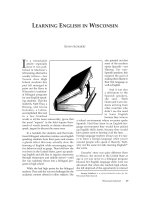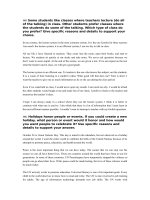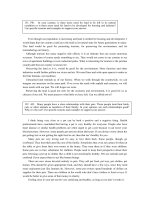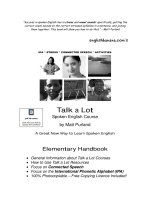Tài liệu Practical English Usage _Part 1_ Michael Swan pdf
Bạn đang xem bản rút gọn của tài liệu. Xem và tải ngay bản đầy đủ của tài liệu tại đây (15.05 MB, 31 trang )
Please purchase PDF Split-Merge on www.verypdf.com to remove this watermark.
Michael Swan
PRACTICAL
ENGLISH
USAGE
Third Edition
OXFORD
UNIVERSITY PRESS
Please purchase PDF Split-Merge on www.verypdf.com to remove this watermark.
OXFORD
UNIVERSITY PRESS
Great Clarendon Street, Oxford
OX2 6DP
Oxford University Press is a department of the University of Oxford.
It furthers the University'sobjectiveof excellencein research, scholarship,
and education by publishing worldwide in
Oxford New York
Auckland Cape Town Dar es Salaam Hong Kong Karachi
Kuala Lumpur Madrid Melbourne Mexico City Nairobi
New Delhi Shanghai Taipei Toronto
With offices in
Argentina Austria Brazil Chile Czech Republic France Greece
Guatemala Hungary Italy Japan Poland Portugal Singapore
South Korea Switzerland Thailand Turkey Ukraine Vietnam
OXFORD
and
OXFORD ENGLISH
are registered trade marks of
Oxford University Press in the UKand in certain other countries
©
Michael Swan
2005
The moral lights ofthe author have been asserted
Database right Oxford University Press (maker)
First published
2005
2009 2008 2007 2006
10 9 8 7 6 5 4
No unauthorized photocopying
All rights reserved. No part ofthis publication may be reproduced,
stored in a retrieval system, or transmitted, in any form or by any means,
without the prior permission in writing of Oxford University Press,
or as expressly permitted by law, or under terms agreed with the appropriate
reprographics rights organization. Enquiries concerning reproduction
outside the scope of the above should be sent to the ELTRights Department,
Oxford University Press, at the address above
Youmust not circulate this book in any other binding or cover
and you must impose this same condition on any acquirer
Any websites referred to in this publication are in the public domain and
their addresses are provided by Oxford University Press for information only.
Oxford University Press disclaims any responsibility for the content
ISBN-13: 9780194420990
(hardback)
ISBN-10: 019442099
X
ISBN-13: 978 0194420983
(paperback)
ISBN-10: 0194420981
Printed in China
Please purchase PDF Split-Merge on www.verypdf.com to remove this watermark.
PRACTICAL ENGLISH USAGE
Please purchase PDF Split-Merge on www.verypdf.com to remove this watermark.
Please purchase PDF Split-Merge on www.verypdf.com to remove this watermark.
Dedication
To John Eckersley, who first encouraged my interest in this kind of thing.
Please purchase PDF Split-Merge on www.verypdf.com to remove this watermark.
Acknowledgements
I am grateful to all the people who have helped me with the preparation of this
third edition. Alarge number of teachers in different countries were kind enough
to respond to an enquiry asking how they felt
Practical English Usage
could be
improved: their feedback was extremely helpful, and I am very much in their
debt. I am also greatly indebted to David Baker, whose comments and
suggestions have added very significantly to the accuracy and clarity of the book,
and to Hideo Hibino and Kenji Kashino, who have contributed valuable advice
on specific problems. Many other teachers and students ~ too many to name -
have taken the trouble to suggest ways in which particular entries could be
improved; their input has benefited the book considerably. My use of the
intern et as a source of instances of authentic usage has been greatly facilitated
by the kind assistance of Hiroaki Sato, of Senshu University, Japan, who made
available his excellent software tool KwiconGugle. I must also reacknowledge my
debt to Ionathan Blundell, Norman Coe, Michio Kawakami, Michael Macfarlane,
Nigel Middlemiss, Keith Mitchell, Catherine Walter, Gareth Watkins, and the
many other consultants and correspondents whose help and advice with the
preparation of the first and second editions continue as an important
contribution to the third.
Any pedagogic grammarian owes an enormous debt to the academic linguists
on whose research he or she is parasitic. There is not enough space to mention
all the scholars of the last hundred years or so on whose work I have drawn
directly or indirectly, even if I had a complete record of my borrowings. But I
must at least pay homage to two monumental reference works of the present
generation: the
Comprehensive Grammar of the English Language,
by Quirk,
Greenbaum, Leech and Svartvik (Longman 1985), and the
Cambridge Grammar
of the English Language,
by Huddleston, Pullum and others (Cambridge
University Press 2002). Their authoritative accounts of the facts of English
structure and usage constitute an essential source of information for anyone
writing pedagogic grammar materials today.
Finally, it is with particular pleasure that I express my gratitude, once again, to
the editorial, design and production team at Oxford University Press, whose
professional expertise is matched only by their concern to make an author's task
as trouble-free as possible.
page vi
Please purchase PDF Split-Merge on www.verypdf.com to remove this watermark.
Contents summary
Page
Acknowledgments
vi
Introduction
viii-x
Contents Overview
xi-xvi
Language Terminology
xvii-xxv
Don't say it:
130 common mistakes
xxvi-xxix
Phonetic alphabet
xxx
Practical English Usage
1-623
Index 624-658
page vii
Please purchase PDF Split-Merge on www.verypdf.com to remove this watermark.
Introduction
The purpose of this book
English, like all languages, is full of problems for the foreign learner. Some of
these points are easy to explain - for instance, the formation of questions, the
difference between
since
and
for,
the meaning of
after all.
Other problems are
more tricky, and cause difficulty even for advanced students and teachers. How
exactly is the present perfect used? When do we use past tenses to be polite?
What are the differences between
at, on
and
in
with expressions of place? We can
say
a chair leg -
why not
*
a cat leg?
When can we use the expression
do so?
When
is
the
used with superlatives? Is
unless
the same as
if not?
What are the
differences between
come
and
go,
between
each
and
every,
between
big, large
and
great,
between
fairly, quite, rather
and
pretty?
Is it correct to say
There's three
more bottles in the fridge?
How do you actually say 3 x 4
=
12?And so on, and
so on.
Practical English Usage
is a guide to problems of this kind. It deals with over 600
points which regularly cause difficulty to foreign students of English. It will be
useful, for example, to a learner who is not sure how to use a particular structure,
or who has made a mistake and wants to find out why it is wrong. It will also be
helpful to a teacher who is looking for a clear explanation of a difficult language
point. There is very full coverage of grammar, as well as explanations of a large
number of common vocabulary problems. There are also some entries designed
to clarify more general questions (e.g. formality, slang, the nature of standard
English and dialects) which students and teachers may find themselves
concerned with.
level
The book is intended for higher level students of English and for teachers. Being
a reference book, it contains information at various levels, ranging from
relatively simple points to quite advanced problems.
Organisation
Problems are mostly explained in short separate entries: the book is more like a
dictionary than a grammar in form. This makes it possible to give a clear
complete treatment of each point, and enables the user to concentrate just on
the question that he or she needs information about. Entries that deal with
related topics (e.g. different uses of a tense) are grouped where this is useful, but
can be read separately. In longer entries, basic information is generally given
first, followed by more detailed explanations and discussions of less important
points. Entries are arranged alphabetically by title and numbered in sequence. A
comprehensive Index (pages 624-658) shows where each point can be found
(see 'How to find things', page x).
Approach and style
I have tried to make the presentation as practical as possible. Each entry
contains an explanation of a problem, examples of correct usage, and (when this
is useful) examples of typical mistakes. In some cases, an explanation may be
somewhat different from that found in many learners' grammars; this is because
page viii
Please purchase PDF Split-Merge on www.verypdf.com to remove this watermark.
the rules traditionally given for certain points (e.g. conditionals or indirect
speech) are not always accurate or helpful. Explanations are, as far as possible, in
simple everyday language. Where it has been necessary to use grammatical
terminology, I have generally preferred to use traditional terms that are simple
and easy to understand, except where this would be seriously misleading. Some
of these terms (e.g. future tense) would be regarded as unsatisfactory by
academic grammarians, but I am not writing for specialists. There is a dictionary
of the terminology used in the book on pages xvii-xxv.
The kind of English described
The explanations deal mainly with standard modern everyday British English,
and are illustrated with realistic examples of current usage. Both explanations
and examples have been thoroughly checked against large electronic databases
('corpora') of authentic spoken and written English. Stylistic differences (e.g.
between formal and informal usage, or spoken and written language) are
mentioned where this is appropriate. The few grammatical differences between
British and American English are also described, and there is a good deal of
information about other British-American differences, but the book is not
intended as a systematic guide to American usage.
Correctness
If people say that a form is not 'correct', they can mean several different things.
They may for instance be referring to a sentence like
*
I have seen her yesterday,
which normally only occurs in the English of foreigners. They may be thinking of
a usage like
less people
(instead of
fewer people),
which is common in standard
English but regarded as wrong by some people. Or they may be talking about
forms like
*
ain't
or 'double negatives', which are used in speech by many British
and American people, but which do not occur in the standard dialects and are
not usually written. This book is mainly concerned with the first kind of
'correctness': the differences between British or American English and 'foreign'
English. However, there is also information about cases of divided usage in
standard English, and about a few important dialect forms. (For a discussion of
different kinds of English, see 308-309.)
How important is correctness?
If someone makes too many mistakes in a foreign language, he or she can be
difficult to understand, so a reasonable level of correctness is important.
However, it is quite unnecessary to speak or write a language perfectly in order
to communicate effectively (very few adults in fact achieve a perfect command
of another language). Learners should aim to avoid serious mistakes (and a book
like
Practical English Usage
will help considerably with this); but they should not
become obsessed with correctness, or worry every time they make a mistake.
Grammar is not the most important thing in the world!
page ix
Please purchase PDF Split-Merge on www.verypdf.com to remove this watermark.
What this book does not do
Practical English Usage
is not a complete guide to the English language. As the
title suggests, its purpose is practical: to give learners and their teachers the most
important information they need in order to deal with common language
problems. Within this framework, the explanations are as complete and accurate
as I can make them. However it is not always helpful or possible in a book of this
kind to deal with all the details of a complex structural point; so readers may well
find occasional exceptions to some of the grammatical rules given here. Equally,
the book does not aim to replace a dictionary. While it gives information about
common problems with the use of a number of words, it does not attempt to
describe other meanings or uses of the words beside those points that are
selected for attention.
Other reference books
A book like this gives explanations of individual points of usage, but does not
show how the separate points 'fit together'. Those who need a systematically
organised account of the whole of English grammar should consult a book such
as the
Oxford Learner's Grammar,
by John Eastwood (Oxford University Press),
A Student's Grammar of the English Language,
by Greenbaum and Quirk
(Longman), or
Collins Cobuild English Grammar
(Collins). For a detailed
treatment of English vocabulary, see the
Oxford Advanced Learner's Dictionary,
the
Cambridge Advanced Learner's Dictionary,
the
Longman Dictionary of
Contemporary English,
the
Macmillan English Dictionary
or the
Collins Cobuild
English Dictionary.
Changes in the third edition
English, like all languages, is changing, and British English is currently being
quite strongly influenced by American English. Consequently, some usages
which were unusual in standard British English a few decades ago have now
become common - for example, the use of
like
as a conjunction (e.g.
like I do),
or
the use of Do
you have ... ?
to ask about the immediate present (e.g.Do
you have
a light?).
The third edition takes account of a number of changes of this kind, in
order to give a fully up-to-date description of contemporary usage.
How to find things
The best way to find information about a particular point is to look in the Index
on pages 624-658. (The overview on pages xi-xvi is intended only to give a
general picture of the topics covered in the book; it is not a complete guide to the
contents.) Most points are indexed under several different names, so it is not
difficult to locate the entry you need. For instance, if you want to know why we
say
I'm not used to driving on the left
instead of
I'm not used to drive on the left,
you can find the number of the section where this is explained by looking in the
index under 'used', 'be used', 'to' or '-ing forms'. (On the other hand, it would
obviously not be helpful to look under 'drive': the rule is a general one about the
use of
-ing
forms after
be used to,
not about the verb
drive
in particular.)
page x
Please purchase PDF Split-Merge on www.verypdf.com to remove this watermark.
Contents Overview
This overview gives a general picture of the topics covered in the book; it is not a
complete guide to the contents. References are to entry numbers. To find
information about a particular point, consult the Index on pages
624-658,
verbs, tense and aspect
future
211-221
present tenses
461-466
past simple and progressive
421-422
perfect verb forms
427
present perfect
455-460
past perfect
423-425
progressive (continuous)
verb forms
470-472
past verb form with present or
future meaning
426
tense simplification in subordinate
clauses (present for future, past
for
would
etc)
580
be, do, have
and modal
auxiliaries
auxiliary verbs 85
be 89-92
there is 587
do 158-162
have 234-239
modal verbs
353-354
can and could 121-125
may and might 338-344
can, could, may and might
compared 345
must 358-361
ought 403
should 518-521
should, ought and must compared
520
will 629
would 633
infinitives and participles
infinitives
279-292
-ing forms
293-294
-ing forms used like nouns
(gerunds)
295-298
-ing form or infinitive after
remember,
go
on
etc
299
-ing and -ed forms used as
adjectives (participles)
408-411
verbs: other points
active verb forms 10
passives
412-420
subjunctive
567
link verbs:
be, seem, look
etc
328
irregular verbs
304
verb complementation (what can
follow a verb?)
606
verbs with two objects
610
verb
+
object
+
complement
607
two-part verbs: phrasal verbs
599;
prepositional verbs
600
verbs of movement
(she ran in
etc)
608
turning verbs into nouns
598
older English verb forms
392
nouns
singular and plural
523-532
countable and uncountable nouns
148-149
gender (references to males and
females)
222
piece- and group-words
(a bar of chocolate, a bunch
of flowers
etc)
430
possessive's
439-440
noun
+
noun
385-386
complementation (what can follow
a noun?)
384
page xi
To find the answer to a specific question, see the Index ~
Please purchase PDF Split-Merge on www.verypdf.com to remove this watermark.









